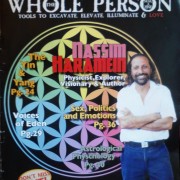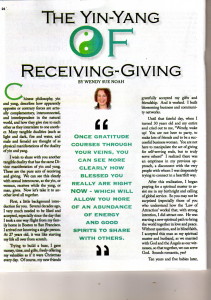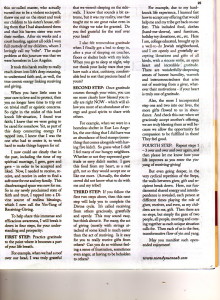 Allow me to introduce one of my very first “Social Media with a Conscience” clients, Robert Strock, Founder of Humanistic Spirituality, Licensed Marriage Family Therapist, Minister, and President of The Global Bridge Foundation . It is truly an honor to work with such a deep, loving, spiritual teacher and real down-to-earth human being.
Allow me to introduce one of my very first “Social Media with a Conscience” clients, Robert Strock, Founder of Humanistic Spirituality, Licensed Marriage Family Therapist, Minister, and President of The Global Bridge Foundation . It is truly an honor to work with such a deep, loving, spiritual teacher and real down-to-earth human being.
What really blew me away was when I was interviewing for this Social Media position with Robert. There I was, Ms. Marketeer, discussing the many ways we could offer a value proposition to generate revenue, and Robert politely informed me that making a profit is not his goal.
What is his goal, then, you ask incredulously?! Good question…
Robert’s sincere heart-felt goal is to inspire purposeful living and compassion for our human condition by offering us contemplative practices for self-transformation, available for free on the Humanistic Spirituality web site, where you will find a plethora of Guided Meditations, audio downloads, readings, and more.
And lucky me! I get to step off the “make a profit” treadmill for a few hours each work day, and share this Divine content and guidance to the masses through social media!
Please make yourself comfortable, and join me for an intimate interview with Robert.
Robert, will you share with our readers how your spiritual path inspired you to form Humanistic Spirituality?
When I was a psychology major in college, I had a recurring dream that I forgot to take my final exams, until the last minute. In the dream, I’d rush into the classroom and stare at the teacher, who looked depressed and more like a caricature than a human being. I’d say to myself, “This person is supposed to teach me how to live a fulfilling life???”
I’d walk out of the classroom laughing at the absurdity of it all and never took the exam in the dream. Then I would wake up. Our supposed mentor had not found her own source of love, inspiration and tenderness. How could she inspire that in her students?
My psychology studies like my dream, felt limited, since they only partially guided me toward my heart and soul. When it came to a fundamentally healthy individual, most of the field of psychology seemed to develop only half of our human potential. That which helps us with personal insight and communication, grounds us in seeing own ego more clarity. It also supports deeper intimacy.
And still, I asked myself over and over, “What other ways are there to find greater happiness and fulfillment?”
It was leaving me half empty.
I had a similar experience in my personal therapy. It was helpful in supporting certain aspects of my growth, but I kept feeling like there was so much more. When I was lucky enough to find a counselor with an open heart and substantial life experience, I felt inspired. But most of the time, I still felt hungry. Was it possible to find fulfillment, or was I living in a dream world?
My longing to find satisfaction motivated me, over a four-decade span, to conduct experiments with human and spiritual potential. When I began the search, I was heartened that these new approaches addressed the central questions that psychology seemed to consider secondary:
- How do I connect to a higher power and potential?
- What does it mean to be truly compassionate? Is a lasting peace possible?
- What can I learn from studying the great masters like Jesus, Buddha, Krishna, Mohammed and a host of others?
I experimented with a variety of approaches that valued the interconnectedness of life, our relationship to death, and the fulfillment of the human soul. It was a relief to finally address a calling I’d always felt deep inside!
Sounds like we are getting closer to the creation of Humanistic Spirituality, yes?
Yes! However, most of these approaches seemed to minimize the importance of appreciating our humanness. If afraid, we were encouraged to have faith or understanding. If we had doubt, we were encouraged to surrender to a higher power.
In theory, these approaches acknowledged the importance of the human experience, but in a limited way. They espoused that once you had “developed, evolved, and found faith,” you had arrived at peace, lightness, equanimity, understanding and compassion.
I was concerned that most teachers didn’t give rich personal examples of the challenges they faced in their own lives. After all, I thought, we are all human beings, even if we walk a path of faith. Why don’t these religious and spiritual teachers expose their humanness by showing us how they fail and how they integrate their healing practices into daily life?
Instead, so many have unwittingly taught their students or followers to idealize the teacher and suppress their suffering.
Thankfully, there have been exceptions. A standout example is Pema Chodron, a highly respected Buddhist nun and teacher, who is clear in valuing the human experience by exposing her own humanness in her talks. At the same time, she teaches the values of heart, compassion, silence, and meditation.
When we are not concerned with bridging the human and the divine, we may tend to focus solely on the ego and our feelings, or put all of our attention on our soul and spirit.
Either way, we are leaving out the other crucial part of ourselves. I understood this inherently as I attempted to help my clients balance whichever tendency was dominant. I would ask someone who was suffering, “How can you take care of yourself?” This would release their fixation on their feelings.
They would choose a method that they felt would best support them. For example, if they had embraced meditation, they might meditate, pray or do some other contemplative practice. If they lived in a more mainstream world, they might choose a more practical approach. In both cases, they were shifting the focus from suffering to asking for relief.
Consistent with movement towards balance, as I saw clients or friends that were spiritual teachers, ministers, and devoted practitioners of certain approaches, I would typically ask them about their greatest challenges and difficult feelings that they were still dealing with.
My instinctive desire to find balance led me to develop an approach I call “Bridging the Human and the Divine” or “Holding of Opposites.” This involves holding our personal, human feelings, just as they are, while we also dedicate ourselves to a chosen practice to support our spirit.
As the Beatles sang, “Whisper words of wisdom—Let It Be.” If we judge ourselves, we are encouraged to be in touch with another side of ourselves that is aware of it and leaves it alone. If we are sad, we do not interfere.
We stay content to simply see things as they are, as we hold two states at the same time.
In closing, can you provide us with a common example of holding these two states at the same time?
Sure, a common example may be: I’m angry with my lover. And, I want to open my heart, not act out, and also discover my needs, which is a prayer and contemplation practice.
Which also happens to be the topic of our most recent blog, “Prayer for Love Relationships“.
Thank you, dear Robert, for you and for your generous heart. I greatly appreciate you sharing your spiritual journey here with us, which helps to give us more of an understanding of Humanistic Spirituality’s roots.
Namaste.






